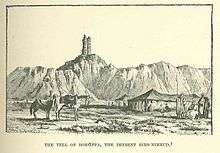Borsippa
Coordinates: 32°23′31.19″N 44°20′30.08″E / 32.3919972°N 44.3416889°E

Borsippa (Sumerian: BAD.SI.(A).AB.BAKI; Akkadian: Barsip and Til-Barsip)[1] or Birs Nimrud (having been identified with Nimrod) is an archeological site in Babylon Province, Iraq. The ziggurat, the "Tongue Tower," today one of the most vividly identifiable surviving ziggurats, is identified in the later Talmudic and Arabic culture with the Tower of Babel. However, modern scholarship concludes that the Sumero-Akkadian builders of the Ziggurat in reality erected it as a religious edifice in honour of the local god Nabu, called the "son" of Babylon's Marduk, as would be appropriate for Babylon's lesser sister-city.
Borsippa was an important ancient city of Sumer, built on both sides of a lake about 17.7 km (11.0 mi) southwest of Babylon on the east bank of the Euphrates.
History
Borsippa is mentioned, usually in connection with Babylon, in texts from the Ur III period through the Seleucid period and even in early Islamic texts. Borsippa was dependent upon Babylon and was never the seat of a regional power. From the 9th century BCE, Borsippa was on the borderland south of which lay the tribal "houses" of Chaldea.
The temple to Nabu at Borsippa was destroyed in 484 BCE during the suppression of a revolt against the Achaemenid king Xerxes.[2]
Archaeology
In 1854 work at Borsippa was conducted under the direction of Henry Creswicke Rawlinson, with most of the actual digging done by his subordinates.[3] Rawlinson personally uncovered the foundation prisms from Nebuchadnezzar II's restoration on the Nabu temple. Between 1879 and 1881 the site was excavated by Hormuzd Rassam for the British Museum.[4][5] He concentrated primarily on Ezida, the temple of Nabu. In 1902, Robert Koldewey worked at Borsippa during his main effort at Babylon also mainly on the Nabu temple.[6]
Since 1980, the Austrian team from the Leopold-Franzens-Universität Innsbruck led by Helga Piesl-Trenkwalder and Wilfred Allinger-Csollich excavated for sixteen seasons at the site. Early work concentrated on the large ziggurat E-ur-imin-an-ki and later on the Nabu temple. Excavations can currently not be carried out due to political events. The elaboration of the results of excavations within the project "Comparative studies of Borsippa - Babylon" are conducted.[7][8]
Many legal administrative and astronomical texts on cuneiform tablets have originated at Borsippa and have turned up on the black market. Archives began to be published in the 1980s. An inscription of Nebuchadrezzar II, the "Borsippa inscription," tells how he restored the temple of Nabu, "the temple of the seven spheres," with "bricks of noble lapis lazuli." that must have been covered with a rich blue glaze, surely a memorable sight. The Austrian archeologists have determined that Nebuchadnezzar's ziggurat encased the ruins of a smaller tower from the second millennium BCE. When it was completed it reached a height of 70 meters, in seven terraces; even in ruin it still stands a striking 52 meters over the perfectly flat plain. Some tablets have been recovered, but archeologists still hope to uncover a temple archive of cuneiform tablets, of which there were some copies in ancient Assyrian libraries. An inscribed foundation stone has been recovered, which details Nebuchadnezzar's plan to have the Borsippa ziggurat built on the same design as that at Babylon, of which only the foundation survives. Nebuchadnezzar declared that Nabu's tower would reach the skies, another inscription states. The reconstruction under the patronage of Bel-Marduk is summarized on a cylinder in Akkadian of Antiochus I, an example of the region's remarkable cultural continuity.[9]
See also
Notes
- ↑ The Cambridge Ancient History: Prolegomena & Prehistory: Vol. 1, Part 1. Accessed 15 Dec 2010.
- ↑ M. A. Dandamayev, "Ezida Temple and the Cult of Nabu in Babilonia of the First Millennium", Vestnik drevnej istorii, no. 3, pp. 87-94, 2009
- ↑ Henry C. Rawlinson, "On the Birs Nimrud, or the Great Temple of Borsippa", The Journal of the Royal Asiatic Society of Great Britain and Ireland, vol. 18, pp. 1-34, 1861
- ↑ Hormuzd Rassam (1897). "Asshur and the Land of Nimrod: Being an Account of the Discoveries Made in the Ancient Ruins of Nineveh, Asshur, Sepharvaim, Calah, (etc)..." (PDF). Curts & Jennings.
- ↑ J. E. Reade," Rassam's Excavations at Borsippa and Kutha, 1879-82", Iraq, vol. 48, pp. 105-116, 1986
- ↑ Robert Koldewey. The excavations at Babylon, University of Michigan Library, 1914; Robert Koldewey, "Die Tempel von Babylon und Borsippa", WVDOG 15, Leipzig, 1911, ISSN 0342-118X
- ↑ W. Allinger-Csollich: Birs Nimrud I. Die Baukörper der Ziqqurat von Borsippa, ein Vorbericht. Baghdader Mitteilungen (BaM). Gbr. Mann, Berlin, vol. 22, pp. 383-499, 1991, ISSN 0418-9698
- ↑ W. Allinger-Csollich, Birs Nimrud II: Tieftempel-Hochtempel: Vergleichende Studien Borsippa - Babylon, Baghdader Mitteilungen, vol. 29, pp. 95-330, 1998, ISSN 0418-9698
- ↑ A. Kuhrt and S. Selwin-White, "Aspects of Seleucid Royal Ideology : The Cylinder of Antiochus I from Borsippa", Journal of Hellenic Studies 111 (1991:71-86)
References
- G. Frame, The "First Families" of Borsippa during the Early Neo-Babylonian Period, Journal of Cuneiform Studies, vol. 36, no. 1, pp. 67–80, 1984
- John P. Peters, The Tower of Babel at Borsippa, Journal of the American Oriental Society, vol. 41, pp. 157–159, 1921
- Francis Joannes, Archives de Borsippa la famille Ea-Iluta-Bani : etude d'un lot d'archives familiales en Babylonie du VIIIe au Ve siecle av. J.-C, Droz, 1989
- Susan Sherwin-White, Aspects of Seleucid Royal Ideology: The Cylinder of Antiochus I from Borsippa, The Journal of Hellenic Studies, vol. 111, pp. 71–86, 1991
- Caroline Waerzeggers, The Carians of Borsippa, Iraq, vol. 68, pp. 1–22, 2006
- Caroline Waerzeggers, The Ezida temple of Borsippa Priesthood, cult, archives (Achaemenid History vol. 15), Leiden, 2010 ISBN 978-90-6258-415-4
External links
| Wikimedia Commons has media related to Borsippa. |
| Wikisource has the text of the 1911 Encyclopædia Britannica article Borsippa. |